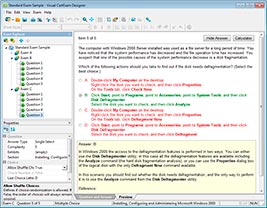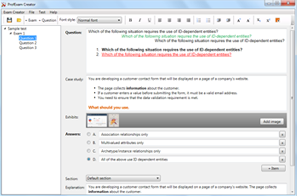Download HashiCorp Certified-Terraform Associate-003.TA-003-P.CertDumps.2025-04-12.62q.vcex
| Vendor: | HashiCorp |
| Exam Code: | TA-003-P |
| Exam Name: | HashiCorp Certified-Terraform Associate-003 |
| Date: | Apr 12, 2025 |
| File Size: | 384 KB |
How to open VCEX files?
Files with VCEX extension can be opened by ProfExam Simulator.
Discount: 20%
Demo Questions
Question 1
A developer on your team is going lo leaf down an existing deployment managed by Terraform and deploy a new one. However, there is a server resource named aws instant.ubuntu[l] they would like to keep.
What command should they use to tell Terraform to stop managing that specific resource?
- Terraform plan rm:aws_instance.ubuntu[1]
- Terraform state rm:aws_instance.ubuntu[1]
- Terraform apply rm:aws_instance.ubuntu[1]
- Terraform destory rm:aws_instance.ubuntu[1]
Correct answer: B
Explanation:
To tell Terraform to stop managing a specific resource without destroying it, you can use the terraform state rm command. This command will remove the resource from the Terraform state, which means that Terraform will no longer track or update the corresponding remote object. However, the object will still exist in the remote system and you can later use terraform import to start managing it again in a different configuration or workspace. The syntax for this command is terraform state rm <address>, where<address> is the resource address that identifies the resource instance to remove. For example, terraform state rm aws_instance.ubuntu[1] will remove the second instance of the aws_instance resource named ubuntu from the state. Reference = : Command: state rm : Moving Resources To tell Terraform to stop managing a specific resource without destroying it, you can use the terraform state rm command. This command will remove the resource from the Terraform state, which means that Terraform will no longer track or update the corresponding remote object. However, the object will still exist in the remote system and you can later use terraform import to start managing it again in a different configuration or workspace. The syntax for this command is terraform state rm <address>, where
<address> is the resource address that identifies the resource instance to remove. For example, terraform state rm aws_instance.ubuntu[1] will remove the second instance of the aws_instance resource named ubuntu from the state. Reference = : Command: state rm : Moving Resources
Question 2
A module can always refer to all variables declared in its parent module.
- True
- False
Correct answer: B
Explanation:
A module cannot always refer to all variables declared in its parent module, as it needs to explicitly declare input variables and assign values to them from the parent module's arguments. A module cannot access the parent module's variables directly, unless they are passed as input arguments. A module cannot always refer to all variables declared in its parent module, as it needs to explicitly declare input variables and assign values to them from the parent module's arguments. A module cannot access the parent module's variables directly, unless they are passed as input arguments.
Question 3
_______backends support state locking.
- All
- No
- Some
- Only local
Correct answer: C
Explanation:
Some backends support state locking, which prevents other users from modifying the state file while a Terraform operation is in progress. This prevents conflicts and data loss. Not all backends support this feature, and you can check the documentation for each backend type to see if it does. Some backends support state locking, which prevents other users from modifying the state file while a Terraform operation is in progress. This prevents conflicts and data loss. Not all backends support this feature, and you can check the documentation for each backend type to see if it does.
Question 4
HashiCorp Configuration Language (HCL) supports user-denned functions.
- True
- False
Correct answer: B
Explanation:
HashiCorp Configuration Language (HCL) does not support user-defined functions. You can only use the built-in functions that are provided by the language. The built-in functions allow you to perform various operations and transformations on values within expressions. The general syntax for function calls is a function name followed by comma-separated arguments in parentheses, such as max(5, 12, 9). You can find the documentation for all of the available built-in functions in the Terraform Registry or the Packer Documentation, depending on which tool you are using. Reference = : Functions - Configuration Language | Terraform : Functions - Configuration Language | Packer HashiCorp Configuration Language (HCL) does not support user-defined functions. You can only use the built-in functions that are provided by the language. The built-in functions allow you to perform various operations and transformations on values within expressions. The general syntax for function calls is a function name followed by comma-separated arguments in parentheses, such as max(5, 12, 9). You can find the documentation for all of the available built-in functions in the Terraform Registry or the Packer Documentation, depending on which tool you are using. Reference = : Functions - Configuration Language | Terraform : Functions - Configuration Language | Packer
Question 5
How does the Terraform cloud integration differ from other state backends such as S3, Consul,etc?
- It can execute Terraform runs on dedicated infrastructure in Terraform Cloud
- It doesn't show the output of a terraform apply locally
- It is only arable lo paying customers
- All of the above
Correct answer: A
Explanation:
This is how the Terraform Cloud integration differs from other state backends such as S3, Consul, etc., as it allows you to perform remote operations on Terraform Cloud's servers instead of your local machine. The other options are either incorrect or irrelevant. This is how the Terraform Cloud integration differs from other state backends such as S3, Consul, etc., as it allows you to perform remote operations on Terraform Cloud's servers instead of your local machine. The other options are either incorrect or irrelevant.
Question 6
How would you output returned values from a child module in the Terraform CLI output?
- Declare the output in the root configuration
- Declare the output in the child module
- Declare the output in both the root and child module
- None of the above
Correct answer: C
Explanation:
To output returned values from a child module in the Terraform CLI output, you need to declare the output in both the child module and the root module. The child module output will return the value to the root module, and the root module output will display the value in the CLI. Reference = [Terraform Outputs] To output returned values from a child module in the Terraform CLI output, you need to declare the output in both the child module and the root module. The child module output will return the value to the root module, and the root module output will display the value in the CLI. Reference = [Terraform Outputs]
Question 7
If a DevOps team adopts AWS CloudFormation as their standardized method for provisioning public cloud resoruces, which of the following scenarios poses a challenge for this team?
- The team is asked to manage a new application stack built on AWS-native services
- The organization decides to expand into Azure wishes to deploy new infrastructure
- The team is asked to build a reusable code based that can deploy resources into any AWS region
- The DevOps team is tasked with automating a manual, web console-based provisioning.
Correct answer: B
Explanation:
This is the scenario that poses a challenge for this team, if they adopt AWS CloudFormation as their standardized method for provisioning public cloud resources, as CloudFormation only supports AWS services and resources, and cannot be used to provision infrastructure on other cloud platforms such as Azure. This is the scenario that poses a challenge for this team, if they adopt AWS CloudFormation as their standardized method for provisioning public cloud resources, as CloudFormation only supports AWS services and resources, and cannot be used to provision infrastructure on other cloud platforms such as Azure.
Question 8
If a DevOps team adopts AWS CloudFormation as their standardized method for provisioning public cloud resoruces, which of the following scenarios poses a challenge for this team?
- The organization decides to expand into Azure wishes to deploy new infrastructure
- The DevOps team is tasked with automating a manual, web console-based provisioning.
- The team is asked to manage a new application stack built on AWS-native services
- The team is asked to build a reusable code based that can deploy resources into any AWS region
Correct answer: A
Question 9
If you manually destroy infrastructure, what is the best practice reflecting this change in Terraform?
- Run terraform refresh
- It will happen automatically
- Manually update the state fire
- Run terraform import
Correct answer: B
Explanation:
If you manually destroy infrastructure, Terraform will automatically detect the change and update the state file during the next plan or apply. Terraform compares the current state of the infrastructure with the desired state in the configuration and generates a plan to reconcile the differences. If a resource is missing from the infrastructure but still exists in the state file, Terraform will attempt to recreate it. If a resource is present in the infrastructure but not in the state file, Terraform will ignore it unless you use the terraform import command to bring it under Terraform's management. Reference = [Terraform State] If you manually destroy infrastructure, Terraform will automatically detect the change and update the state file during the next plan or apply. Terraform compares the current state of the infrastructure with the desired state in the configuration and generates a plan to reconcile the differences. If a resource is missing from the infrastructure but still exists in the state file, Terraform will attempt to recreate it. If a resource is present in the infrastructure but not in the state file, Terraform will ignore it unless you use the terraform import command to bring it under Terraform's management. Reference = [Terraform State]
Question 10
In a Terraform Cloud workpace linked to a version control repository speculative plan rum start automatically commit changes to version control.
- True
- False
Correct answer: A
Explanation:
When you use a remote backend that needs authentication, HashiCorp recommends that you: When you use a remote backend that needs authentication, HashiCorp recommends that you:
Question 11
In Terraform HCL, an object type of object ({name=string, age-number}) would match this value.
Correct answer: B
HOW TO OPEN VCE FILES
Use VCE Exam Simulator to open VCE files

HOW TO OPEN VCEX AND EXAM FILES
Use ProfExam Simulator to open VCEX and EXAM files


ProfExam at a 20% markdown
You have the opportunity to purchase ProfExam at a 20% reduced price
Get Now!








